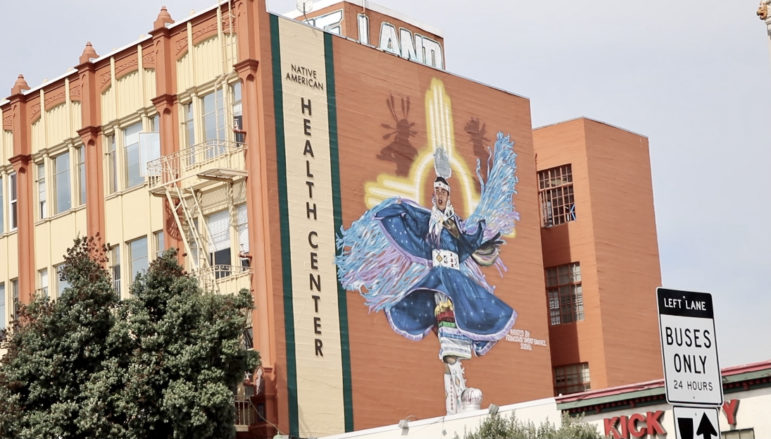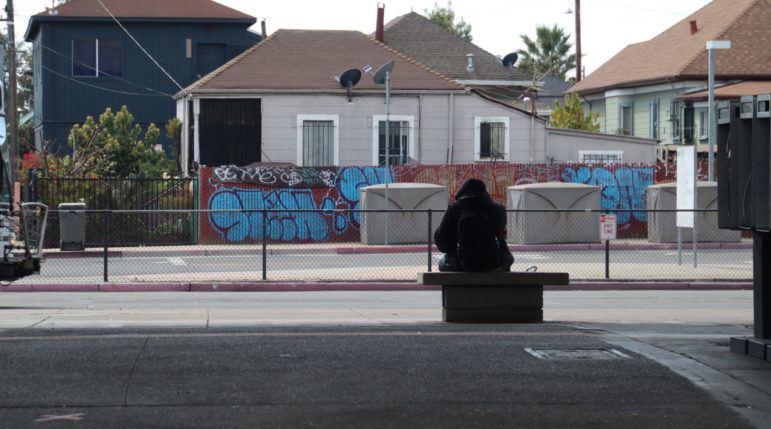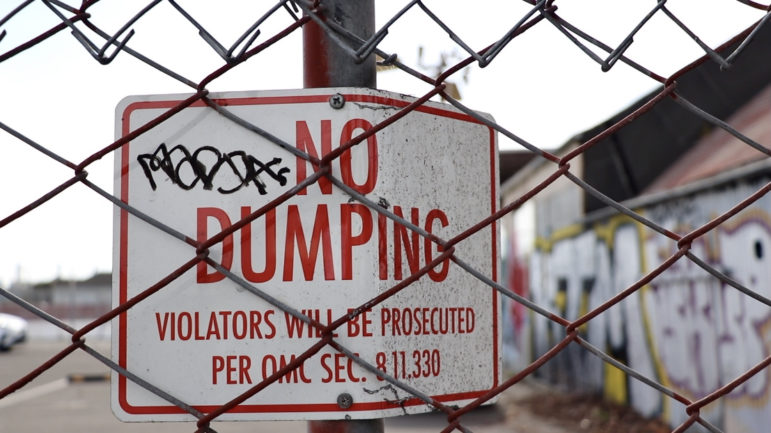
Fruitvale Village is a commuter plaza that sits opposite the train station.

This article is an accompanying piece to the Outlook’s video “Fruitvale, Oakland | Lead poisoning in the Bay Area ” which you can watch on our YouTube channel. A full list of everyone who contributed to this project can be found in the video’s credits.
At first glance, the Fruitvale neighborhood of Oakland may appear as little more than a commuter plaza nestled next to a bustling Bay Area Rapid Transit station. Between public markets, an Oakland library stand, check-cashing storefronts and mom-and-pop restaurants, many residents set up street markets to sell fresh fruit, juices or trinkets. In reality, it’s a neighborhood with a deep history, which can be traced all the way back to when it was inhabited by the Ohlone people, before conquistadors arrived to the West Coast in the 18th century, before its later incorporation into America in the 19th century or the urbanization that transformed it into the Oakland we recognize today.
One of the first things a visitor to Fruitvale might notice are city blocks of antiquated houses, the exterior paint of many being in a clear state of decay. A large number of houses in Oakland were built before a federal ban on lead paint was put in place in 1978, which means the older houses may have lead paint under layers of newer paint or never got repainted at all. Many of these lead-contaminated houses, which can pose a severe health hazard to inhabitants, are concentrated in the Fruitvale neighborhood. As paint chips off of walls, children can ingest it, it can enter the soil or contaminate water supplies. In fact, nearly 7.5% of children under the age of six living in Fruitvale experienced lead poisoning in 2012: five times greater than California’s lead poisoning rate.

Inequality is often a side effect of urbanization, especially in the Bay Area, which has seen several distinct epochs of demographic makeup of inhabitants. According to data from 2016, 53.8% of Fruitvale’s population was Hispanic, the highest concentration in any neighborhood in Oakland, and it seems to have evaded gentrification for the most part. A 2019 American Community Survey reported that almost a quarter of Fruitvale’s residents were not U.S. citizens, and 22.5% live below the poverty threshold.
“Inequality is often a side effect of urbanization, especially in the Bay Area”
Located less than five miles from Downtown Oakland, Fruitvale remains unpopular with Bay Area tourists and visitors due to it being largely residential and possibly perceived as a place with endemic violent crime. The neighborhood was recently referenced in the 2013 film, “Fruitvale Station,” based on the true story of a man who was fatally shot by BART police officers at the Fruitvale train station in 2010. More recent mentions of Fruitvale were written into Native American novelist Tommy Orange’s critically acclaimed book “There There,” published in 2018, which was a semi-autobiographical account of Orange’s experience growing up in Oakland and working at the Native American Health Center in Fruitvale. Orange’s novel centers the experiences of Native Americans’ attempts to preserve their cultural identity in urban settings, and takes its name from a famous and often misinterpreted Gertrude Stein quote. Stein describes her experience growing up in Oakland and returning several decades later, unable to recognize the city after a population boom caused the area to rapidly urbanize. “There is no there there,” she wrote.

The first period of gentrification in the city of Oakland began in 1993 and occurred largely because of the construction of transit communities, like the Fruitvale Village, and the demolition of low-income housing. As public transit systems like BART are established in lower-income neighborhoods of urban areas, gentrification often follows as white collar workers move to an area where rent and cost of living are more affordable while retaining an easy commute to work in different neighborhoods. Part of Fruitvale’s lead problem exists in part because it hasn’t been gentrified as much as other areas of Oakland and where new housing would have been constructed, old buildings with lead paint intact still stand.
In his thesis “The First Cycle of Gentrification in West Oakland, California,” Jason Zimmerman describes how the suburbanization of Oakland occurred with the help of government real estate subsidies and private companies taking advantage of people’s desire to live in an immigrant community like Fruitvale: “working class areas were promoted to the new middle class as economical and exotic alternatives to the suburbs.”

These periods of gentrification followed a long era of “white flight” from Oakland, where the demographics of the city radically shifted as white residents began to migrate out of more urban areas to establish suburbs that still exist today, such as Piedmont, Walnut Creek and areas of Contra Costa County. During a period of “urban renewal” in the 1950s, Hispanic and Black residents of West Oakland were displaced and relocated to the east part of the city, including the Fruitvale neighborhood.
Despite the recent development of the commuter village, the Fruitvale neighborhood has been studied as an example of “development without displacement,” meaning that more modern additions to the neighborhood, like a charter school, a public library and a farmers market, have been established without causing any dramatic shift in the population makeup of the area.

While the culture of Fruitvale has been preserved, and its diverse ethnic makeup remained mostly intact, progress on issues like lead contamination have remained stagnant. Although Fruitvale’s high lead poisoning rate is due mostly to outdated architecture and a slow governmental response to the crisis, or feigned ignorance of its severity, it’s easy to draw parallels to the recent lead crisis in Flint, Michigan. At the very least, there are apparent connections in the socioeconomic and racial makeup of cities most affected.
Flint’s lead crisis, where a lack of clean water plagued residents (54% of which are Black, according to the U.S. Census Bureau in 2019) has populated the news cycle for over half a decade. The crisis began with the emergency appointment of an unelected city official, Darnell Early, who was tasked with cutting costs for a city already deep in debt. His solution included switching the public water supply from the Detroit River to the Flint River as well as putting a stop to chemically treating the water, which experts say would have only cost around $80 a day.
In mere months, both fecal coliform and Legionnaires’ disease-causing bacteria were detected in the water, and an outbreak of the disease caused a dozen resident deaths. The people of Flint continued to only have access to contaminated water, which was soon found to have dangerously high levels of lead. They implored the city government to recognize the danger in their undrinkable water supply, but were ignored. The city government denied that anything was wrong with the water while filtered water was provided for government officials to drink. Flint’s environmental injustice was declared a federal emergency — nearly 100,000 residents were exposed to lead through the drinking supply — and Flint’s government faced civil lawsuits or even stood trial for involuntary manslaughter.

Lead’s long-term effects are brutal, and contamination over time disproportionately hits minority communities like Flint and Fruitvale the hardest. Lead poisoning causes irreversible brain damage in children, disrupting normal cognitive development which decreases ability to focus, can cause underperformance in school and has been proven to drop IQ scores several points. In adults, exposure to lead can even cause lowered sperm counts or abnormal sperm, and miscarriages, stillbirths or premature births.
“Lead’s long-term effects are brutal, and contamination over time disproportionately hits minority communities … the hardest”
Michael Mascarenhas, a professor at the University of California, Berkeley, works in the Department of Environmental Science, Policy and Management. He believes that capitalist industries can cause people of color and impoverished people to have irregular exposure to lead in two ways: first that the jobs that the socioeconomically disadvantaged frequently work expose them to more toxicity and health hazards than the average white collar worker and second, that industries whose production has serious environmental ramifications choose to target minority areas geographically.
“The leading indicator of where a hazardous waste site will be located in this country is race,” Mascarenhas said. “It’s people of color who live in these neighborhoods and industry actually comes in after them … and [this is enabled by] a racist … system of government that has created ghettos [and] segregated residential areas, either through gerrymandering [or] redlining.”

This concept relates to that of racial capitalism, which hypothesizes that society commodifies racial identities, and extracts wealth from non-white people. This collection of capital, according to scholars, can only happen through acute inequality. In Fruitvale, this manifests itself as a guarantee that residents will continue to pay rent and inhabit a neighborhood permeated by lead poisoning without any comprehensive or all-encompassing government plan to stop this dangerous risk to their health. Consequently, systems of power are placing less value on the lives of Fruitvale’s inhabitants, like what was done for many years in Flint, because of their ethnic identities, citizenship status, wealth or how important people deem their well-being to be.
Sociologist Ruth Wilson Gilmore once defined racism in complete geographical terms, writing that “racism, specifically, is the state-sanctioned or extralegal production and exploitation of group-differentiated vulnerability to premature death.”
“Racism … is the state-sanctioned [and] group-differentiated vulnerability to premature death”
Fruitvale is a clear example of environmental health hazards that have a disparate impact on minority neighborhoods. But it’s not a problem with an easy solution. While local governments do make efforts to test for lead in homes, help is not accessible to everyone who needs it. A new wave of gentrification may make way for construction of new homes and bring money into the area to rebuild, but in doing so it would push out the current inhabitants, leaving the culture of the neighborhood a piece of lost history. Displaced residents, who would likely be disproportionately minorities and socioeconomically disadvantaged, would probably be pushed into a neighborhood with its own set of problems as Oakland continued to develop without them.





Thank you for researching and understanding and explaining things in such a clear and concise way. This is a good, worth-while read. I believe you are part of the solution. Keep up the great work.
Great article, but it is only part of the history of Fruitvale. As an overview – the railroad delivered diesel fuel from a pipeline ending at Glascock and Derby Avenue, which also was the east end of Shell Tank Farm. The 2 pipes are still under Derby Avenue – never capped. Imagine when the railroad was reopened and the RR reconstructed the tracks – I asked an engineer if he contacted Shell – 10’ away said a sign covered in growth warned not to dig in the area and call Shell for more info. He saw the sign and just went on with his day as no big deal. He also mentioned the tests from that location had indicated a high level of contaminants in the soil but no remediation was needed as the street was going to cover and seal it up. A trip to Oakland’s city planning office had numerous files of all the permits for building that were just approved with little or no remediation including 400 Derby – The Boathouse – a location that received approval just because it was one of the first locations. The Shell tank farm. Now sits the UC at Berkeley Boat House and next to it the Signature Home Condos interesting note is the area had 5’ of earth removed and trucked off. The replacement fill came from another project across the street on Glascock as a 4 level parking garage was approved and needed somewhere to put the soil with no testing as the property never had a business that would have contaminated the land. But the water flows not to the estuary but south to the creek direct west south of the land that the soil was removed as fill dirt. There are 50+ monitoring wells in the area that for were monitored weekly. Some of the reports 10 years after the remediation showed alarming test results – as the petroleum was breaking up releasing other chemicals and off gassing contaminants. Then the information stopped as the company doing the reports and city stopped releasing the info.
So great that lead was uncovered – but someone needs to dig deeper to find out the true story of the area and the legacy of Oaklands efforts to build a new alternative affordable housing community. In 5-10 years no one will even know of the 40+ buildings once in the area that poured chemicals down the drain, dumped in the drainage, on the property grounds including oil, gasoline, arsenic, lead, and many other chemicals.